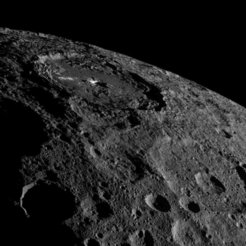Dawn: Soaring to new heights

NASA's spaceprobe Dawn is underway to a new orbit around dwarf planet Ceres. On 4 November, 2016, Dawn left its latest position approximately 1480 meters above the surface. At the beginning of December, the spacecraft is scheduled to reach its new height of 7200 kilometers. From there, especially measurements wit the instrument GraND, a detector for gamma rays and neutrons, are planned.
On its way to its new position, on 16 October, 2016, Dawn's onboard camera system captured this image of Occator Crater (at the top, a little to the left). Scientists from the Max Planck Institute for Solar System Research regard the bright spot in the center close the remains of a central peak as signs of recent geological activity, Their results suggest, that the bright material consists mainly of carbonates. Due to the impact, that once formed the crater, these may have emerged from below as part of a brine. While the water evaporated over time, the carbonates remained behind.
The image was taken from a distance of 1480 kilometers and has a resolution of 140 meters per pixel.
Dawn's mission to Vesta and Ceres is managed by the Jet Propulsion Laboratory for NASA's Science Mission Directorate in Washington. Dawn is a project of the directorate's Discovery Program, managed by NASA's Marshall Space Flight Center in Huntsville, Alabama. UCLA is responsible for overall Dawn mission science. Orbital ATK, Inc., of Dulles, Virginia, designed and built the spacecraft. JPL is managed for NASA by the California Institute of Technology in Pasadena. The framing cameras were provided by the Max Planck Institute for Solar System Research, Gottingen, Germany, with significant contributions by the German Aerospace Center (DLR) Institute of Planetary Research, Berlin, and in coordination with the Institute of Computer and Communication Network Engineering, Braunschweig. The framing camera project is funded by the Max Planck Society, DLR, and NASA.
